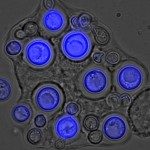Link to Pubmed [PMID] – 12435690
Antimicrob. Agents Chemother. 2002 Dec;46(12):3869-76
The pathogenic yeast Candida albicans displays at its cell surface beta-1,2 oligomannosides (beta-1,2-Mans). In contrast to the ubiquitous alpha-Mans, beta-1,2-Mans bind to galectin-3, a major endogenous lectin expressed on epithelial cells. The specific role of beta-1,2-Mans in colonization of the gut by C. albicans was assessed in a mouse model. A selected virulent strain of C. albicans (expressing more beta-1,2-Man epitopes) induced more intense and sustained colonization than an avirulent strain (expressing less beta-1,2-Man epitopes). Synthetic (Sigma) beta-and alpha-linked tetramannosides with antigenicities that mimicked the antigenicities of C. albicans-derived oligomannosides were then constructed. Oral administration of Sigmabeta-1,2-Man (30 mg/kg of body weight) prior to inoculation with the virulent strain resulted in almost complete eradication of yeasts from stool samples, whereas administration of Sigmaalpha-Man at the same dose did not. As most cases of human systemic candidiasis are endogenous in origin, this first demonstration that a synthetic analogue of a yeast adhesin can prevent yeast colonization in the gut opens the possibility of new prophylactic strategies.
